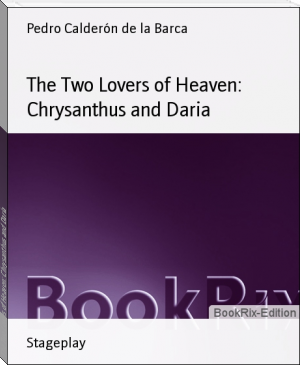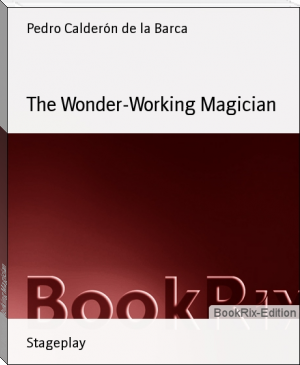The Two Lovers of Heaven: Chrysanthus and Daria by Pedro Calderón de la Barca (smart books to read txt) 📖

- Author: Pedro Calderón de la Barca
Book online «The Two Lovers of Heaven: Chrysanthus and Daria by Pedro Calderón de la Barca (smart books to read txt) 📖». Author Pedro Calderón de la Barca
Calderon's Family Motto.
"POR LA FE MORIRE". - FOR THE FAITH WELCOME DEATH.
THIS motto is taken from the engraved coat of arms prefixed to an historical account of "the very noble and ancient house of Calderon de la Barca"-a rather scarce work which I have never seen alluded to in any account of the poet. The circumstances from which the motto was assigned to the family are given with some minuteness at pp. 56 and 57 of the work referred to. It is enough to mention that the martyr who first used the expression was Don Sancho Ortiz Calderon de la Barca, a Commander of the Order of Santiago. He was in the service of the renowned king, Don Alfonso the Wise, towards the close of the thirteenth century, and having been taken prisoner by the Moors before Gibraltar, he was offered his life on the usual conditions of apostasy. But he refused all overtures, saying: "Pues mi Dios por mi murio, yo quiero morir por el", a phrase which has a singular resemblance to the key note of this drama. Don Ortiz Calderon was eventually put to death with great cruelty, after some alternations of good and bad treatment. See "Descripcion, Armas, Origen, y Descendencia de la muy noble y antigua Casa de Calderon de la Barca", etc., que Escrivio El Rmo. P. M. Fr. Phelipe de la Gandara, etc., Obra Postuma, que saca a luz Juan de Zuniga. Madrid, 1753.
D. F. M. C.
TO HENRY WADSWORTH LONGFELLOW,
IN GRATEFUL RECOLLECTION OF SOME DELIGHTFUL DAYS SPENT WITH HIM AT ROME,
This Drama is dedicated BY DENIS FLORENCE MAC-CARTHY.
TO LONGFELLOW.
I.
PENSIVE within the Colosseum's walls
I stood with thee, O Poet of the West!-
The day when each had been a welcome guest
In San Clemente's venerable halls:- Ah, with what pride my memory now recalls
That hour of hours, that flower of all the rest,
When with thy white beard falling on thy breast-
That noble head, that well might serve as Paul's In some divinest vision of the saint
By Raffael dreamed, I heard thee mourn the dead-
The martyred host who fearless there, though faint, Walked the rough road that up to Heaven's gate led:
These were the pictures Calderon loved to paint
In golden hues that here perchance have fled.
II.
YET take the colder copy from my hand,
Not for its own but for THE MASTER'S sake,-
Take it, as thou, returning home, wilt take
From that divinest soft Italian land Fixed shadows of the Beautiful and Grand
In sunless pictures that the sun doth make-
Reflections that may pleasant memories wake
Of all that Raffael touched, or Angelo planned:- As these may keep what memory else might lose,
So may this photograph of verse impart
An image, though without the native hues Of Calderon's fire, and yet with Calderon's art,
Of what Thou lovest through a kindred Muse
That sings in heaven, yet nestles in the heart.
D. F. M. C.
Dublin, August 24th, 1869.
PREFATORY NOTE.
THE PROFESSOR OF POETRY AT OXFORD AND THE AUTOS SACRAMENTALES OF CALDERON.
Although the Drama here presented to the public is not an 'Auto,' the present may be a not inappropriate occasion to draw the attention of all candid readers to the remarks of the Professor of Poetry at Oxford on the 'Autos Sacramentales' of Calderon-remarks founded entirely on the volume of translations from these Autos published by me in 1867,[*] although not mentioned by name, as I conceive in fairness it ought to have been, by Sir F. H. Doyle in his printed Lectures.[+]
In his otherwise excellent analysis of The Dream of Gerontius, Sir F. H. Doyle is mistaken as to any direct impression having been made upon the mind of Dr. Newman in reference to it by the Autos of Calderon. So late as March 3, 1867, in thanking me for the volume made use of by Sir F. H. Doyle, Dr. Newman implies that up to that period he had not devoted any particular attention even to this most important and unique development of Spanish religious poetry. The only complete Auto of Calderon that had previously appeared in English-my own translation of The Sorceries of Sin, had, indeed, been in his hands from 1859, and I wish I could flatter myself that it had in any way led to the production of a master-piece like The Dream of Gerontius. But I cannot indulge that delusion. Dr. Newman had internally and externally too many sources of inspiration to necessitate an adoption even of such high models as the Spanish Autos. Besides, The Dream of Gerontius is no more an Auto than Paradise Lost, or the Divina Commedia. In these, only real personages, spiritual and material, are represented, or monsters that typified human passions, but did not personify them. In the Autos it is precisely the reverse. Rarely do actual beings take part in the drama, and then only as personifications of the predominant vices or passions of the individuals whose names they bear. Thus in my own volume, Belshazzar is not treated so much as an historical character, but rather as the personification of the pride and haughtiness of a voluptuous king. In The Divine Philothea, in the same volume, there are no actual beings whatever, except The Prince of Light and The Prince of Darkness or The Demon. In truth, there is nothing analogous to a Spanish Auto in English original poetry. The nearest approach to it, and the only one, is The Prometheus Unbound of Shelley. There, indeed, The Earth, Ocean, The Spirits of the Hours, The Phantasm of Jupiter, Demogorgon, and Prometheus himself, read like the 'Personas' of a Spanish Auto, and the poetry is worthy the resemblance. The Autos Sacramentales differ also, not only in degree but in kind from every form of Mystery or Morality produced either in England or on the Continent. But to return to the lecture by Sir F. H. Doyle. Even in smaller matters he is not accurate. Thus he has transcribed incorrectly from my Introduction the name of the distinguished commentator on the Autos of Calderon and their translator into German-Dr. Lorinser. This Sir F. H. Doyle has printed throughout his lecture 'Lorinzer'. From private letters which I have had the honour of receiving from this learned writer, there can be no doubt that the form as originally given by me is the right one. With these corrections the lecture of Sir F. H. Doyle may be quoted as a valuable testimony to the extraordinary poetic beauty of these Autos even in a translation.
LECTURE III.-Dr. Newman's Dream of Gerontius.
"It is probable, indeed, that the first idea of composing such a dramatic work may have been suggested to Dr. Newman by the Autos Sacramentales of Spain, and especially by those of the illustrious Calderon; but, so far as I can learn, he has derived hardly anything from them beyond the vaguest hints, except, indeed, the all-important knowledge, that a profound religious feeling can represent itself, and that effectively, in the outward form of a play. I may remark that these Spanish Autos of Calderon constitute beyond all question a very wonderful and a very original school of poetry, and I am not without hope that, when I know my business a little better, we may examine them impartially together. Nay, even as it is, Calderon stands so indisputably at the head of all Catholic religious dramatists, among whom Dr. Newman has recently enrolled himself, that perhaps it may not be out of place to inquire for a moment into his poetical methods and aims, in order that we may then discover, if we can, how and why the disciple differs from his master. Now there is a great conflict of opinion as to the precise degree of merit which these particular Spanish dramas possess. Speaking as an ignorant man, I should say, whilst those who disparage them seem rather hasty in their judgments, and not so well informed as could be wished, still the kind of praise which they receive from their most enthusiastic admirers puzzles and does not instruct us.
"Taking for example, the great German authority on this point, Dr. Lorinzer [Lorinser], as our guide, we see his poet looming dimly through a cloud of incense, which may embalm his memory, but certainly does not improve our eyesight. Indeed, according to him, any appreciation of Calderon is not to be dreamt of by a Protestant". Lectures, pp. 109, 110.
With every respect for Sir F. H. Doyle, Dr. Lorinser says no such thing. He was too well informed of what had been done in Germany on the same subject, before he himself undertook the formidable task of attempting a complete translation of all the Autos of Calderon, to have fallen into such an error. Cardinal Diepenbrock, Archbishop of Breslau, who, in his "Das Leben ein Traum" (an Auto quite distinct from the well known drama "La Vida es Sueno") first commenced this interesting labour in Germany, was of course a Catholic. But Eichendorff and Braunfels, who both preceded Dr. Lorinser, were Protestants. Augustus Schlegel and Baron von Schack, who have written so profoundly and so truly on the Autos, are expressly referred to by Dr. Lorinser, and it is superfluous to say that they too were Protestants. Sir F. H. Doyle, in using my translation of the passage which will presently be quoted, changes the word 'thoroughly' into 'properly', as if it were a more correct rendering of the original. Unfortunately, however, there is nothing to represent either word in the German. Dr. Lorinser says, that by many, not by all, Calderon cannot be enjoyed as much as he deserves, because a great number of persons best competent to judge of his merits are deficient in the knowledge of Catholic faith and Catholic theology which for the understanding of Calderon is indispensible-"welche fuer Calderons Verstaendniss unerlaesslich ist". Sir F. H. Doyle says that to him these Autos are not "incomprehensible at all" (p. 112), but then he understands them all the better for being a scholar and a churchman.
Sir F. H. Doyle thus continues his reference to Dr. Lorinser. "Even learned critics", he says, "highly cultivated in all the niceties of aesthetics, are deficient in the knowledge of Catholic faith and Catholic theology properly to understand Calderon" (Lectures, p. 110, taken from the Introduction to my volume, p. 3). "Old traditions", continues Dr. Lorinzer, "which twine round the dogma like a beautiful garland of legends, deeply profound thoughts expressed here and there by some of the Fathers of the Church, are made use of with such incredible skill and introduced so appositely at the right place, that . . . . frequently it is not easy to guess the source from whence they have been derived" (Lectures, p. 111, taken from
 In literature a drama genre deserves your attention. Dramas are usually called plays. Every person is made up of two parts: good and evil. Due to life circumstances, the human reveals one or another side of his nature. In drama we can see the full range of emotions : it can be love, jealousy, hatred, fear, etc. The best drama books are full of dialogue. This type of drama is one of the oldest forms of storytelling and has existed almost since the beginning of humanity. Drama genre - these are events that involve a lot of people. People most often suffer in this genre, because they are selfish. People always think to themselves first, they want have a benefit.
In literature a drama genre deserves your attention. Dramas are usually called plays. Every person is made up of two parts: good and evil. Due to life circumstances, the human reveals one or another side of his nature. In drama we can see the full range of emotions : it can be love, jealousy, hatred, fear, etc. The best drama books are full of dialogue. This type of drama is one of the oldest forms of storytelling and has existed almost since the beginning of humanity. Drama genre - these are events that involve a lot of people. People most often suffer in this genre, because they are selfish. People always think to themselves first, they want have a benefit.




Comments (0)